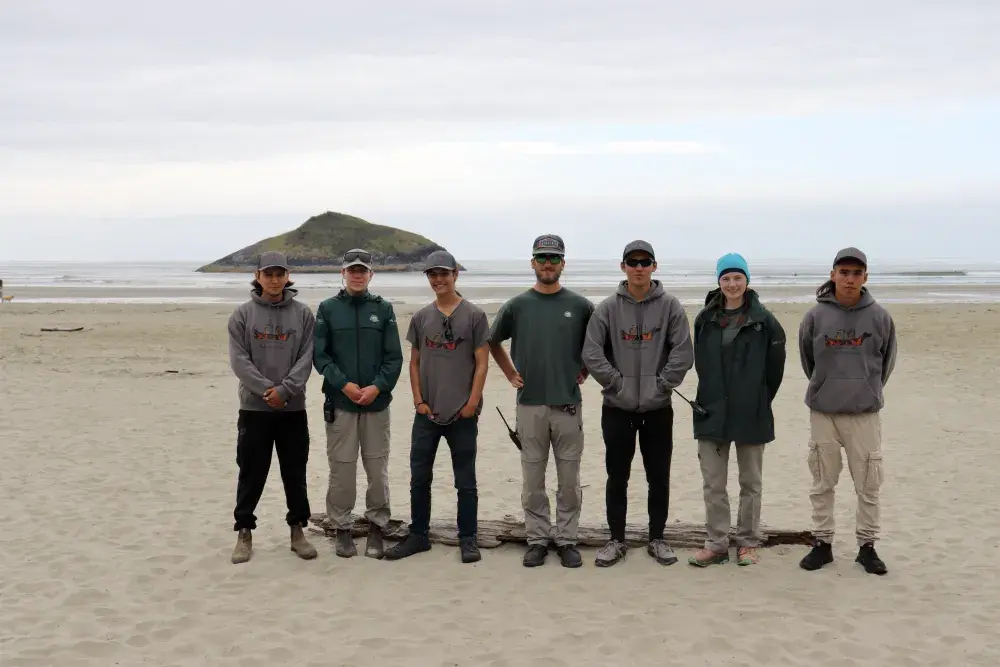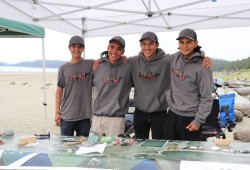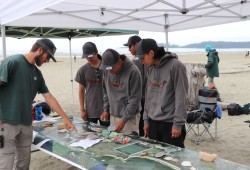A whiteboard noting the Nuu-chah-nulth word of the day, ‘siiksaanapšiity̓ak’, meaning surfboard and pronounced seek-saw-nup-sheelth-yak, reels visitors in towards a new knowledge point on Long Beach in the Pacific Rim National Park Reserve, in Tla-o-qui-aht First Nations traditional territory.
From there, Indigenous Coastal Guardians Ivan Wells Jr., Chance Fred, Mohkin Masso and Andrew Clappis Jr. add a new layer to the usual Parks Canada visitor safety experience by sharing tidbits of Nuu-chah-nulth culture.
The young men use a giant map of the Pacific Rim to show landmarks. They have photo cards depicting wild berries and local vegetation, plus a collection of shells – scallop, varnish clams, cockle clam, mussel and limpit – to introduce beachgoers to the traditional intertidal smorgasbord.
“Most visitors have a healthy curiosity about Nuu-chah-nulth culture and just having that space to talk about it is cool. There are a handful of people that just don’t know anything that want to know more,” said Wells Jr., 23, who is from Ehattesaht near Zeballos, one of 14 Nuu-chah-nulth First Nations.
Wells Jr., Fred, Masso and Clappis Jr. are piloting the newly launched Indigenous Coastal Youth (ICY) Safety Program, an initiative run by the Nuu-chah-nulth Youth Warrior Family Society, an Indigenous-led non-profit, and supported by Parks Canada. They were not hired by Parks to provide first responder services, explains program lead Sheena Charleson, but rather to give the term “coastal safety” a new meaning: to uphold cultural traditions and values that remind us to take care of ourselves, one another and our coastal communities.
“The ICY Safety Program is more than a program addressing coastal safety. It is a wholistic way of being rooted in mentorship and learning through time spent with elders,” said Charleson.
The full-time job includes Long Beach Unit Days, where the Coastal Guardians are boots-on-the-beach interacting with visitors, and Harvesting Days where they’re working on the water or with the land, participating in resource monitoring or cultural harvest practices.
Since their contract started in the spring, they’ve helped build a clam garden, gone cedar pulling, conducted kelp surveys and supported Parks Canada with shellfish and bat monitoring.
“You go out and set-up microphones and record the sound. It gives you the idea of bat populations in certain areas. It’s been super educational working with Parks,” said Wells Jr.
Alison Stacey is a Coastal Steward supervisor for Parks Canada. Originally from Ontario, Stacey says it’s been an “honour” to work alongside the Indigenous Coastal Guardians this summer.
“It’s been a great addition. The Coastal Stewards in the past have a lot of information on water safety, but one thing our program has always lacked is the Indigenous perspective and the knowledge of the land that we’re on,” said Stacey.
Nuu-chah-nulth Youth Warrior Family Society co-ordinator Dr. Ricardo Manmohan told the Ha-Shilth-Sa that the program came to fruition shortly after Parks Canada First Nations program manager Tammy Dorward put forward the idea to fund an initiative that involved Indigenous Coastal Stewards.
“We are working in partnership and reconciliation with Parks. The program shifts from visitor experience towards harvesting in October. That’s the magic of this,” emphasized Manmohan.
He went on to add that the youth and the Nuu-chah-nulth matriarchs guide the Warrior Leadership Program.
“We have an opportunity to showcase Parks in a different light and maybe, hopefully, we can create something that can be showcased across other parts of Canada to other parks that are on nation land,” Manmohan said.
As the summer crowds thin, the Coastal Guardians are checking the tide charts and looking ahead to a busy fall schedule of harvesting, hunting and freediving.
“The bigger mission for us is to equip us, these young men, with real livable experience and real-life knowledge about living here in this coastal environment and these ecosystems,” said Wells Jr.



